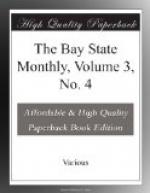There is one hotel in the settled part of the town, the Cushing House.
The town is abundantly supplied with water of the purest quality for domestic and fire purposes, from Accord Pond, situated on the southern boundary line of the town, and there is an excellent fire department.
There is a weekly paper (The Hingham Journal), a national bank, a savings-bank, and a fire insurance company, which, with numerous stores in almost every department of domestic supplies, largely make up the business of the town.
The Hingham Agricultural and Horticultural Society holds monthly meetings and an annual exhibition in its spacious hall and grounds.
The views from several of the hills in Hingham are very beautiful, and its woods and fields afford a large and varied study for the botanist.
Of a high average of intelligence, attentive to education, encouraging morality, obedient to the laws, the people of Hingham have always stood high in the scale of social enjoyment and prosperity. Its town meetings are models of democratic government, and there are few places in which this purely American institution is preserved with so much respect and true regard for the public welfare.
It is with justifiable pride that the native of Hingham looks back through the two and one-half centuries of her history.
“Such is the patriot’s boast,
where’er we roam,
His first, best country ever is at home.”
* * * * *
THE HOUSE OF TICKNOR.
WITH A GLIMPSE OF THE OLD CORNER BOOKSTORE.
By Barry Lyndon.
The great Boston fire of 1872 had a forerunner in the same city. In 1711 a most sweeping conflagration occurred, which burned down all the houses on both sides of Cornhill, from School street to Dock square, besides the First Church, the Town House, all the upper part of King street, and the greater part of Pudding Lane, between Water street and Spring Lane. Nearly one hundred houses were destroyed, of which the debris was used to fill up Long Wharf. The fire “broke out,” says an account in the Boston News-Letter, “in an old tenement within a backyard in Cornhill, near the First Meeting-house, occasioned by the carelessness of a poor Scottish woman by using fire near a parcel of ocum, chips, and other combustible rubbish.”
The houses which were rebuilt along Cornhill, soon after the fire, were “of brick, three stories high, with a garret, a flat roof, and balustrade.” Several of these houses were still standing in 1825; in 1855 only a very few remained; while only one, so far as we know, has come down to us to-day and is yet even well-preserved, namely, the Old Corner Bookstore, on the corner of the present Washington and School streets.




